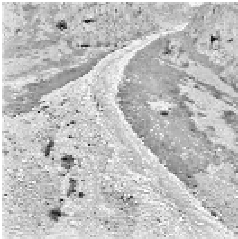Geology Reference
In-Depth Information
7
Rates of erosion and uplift
We recognize that the landscape in actively
deforming areas results from interactions among
the processes of rock uplift, subsidence, and
surface processes that can lead to local erosion
and deposition. It is useful, therefore, to try to
calibrate the rates and relative contributions of
each process at a particular time or over some
span of time. The goals of this chapter are to
describe approaches that can be employed to
define geomorphic and tectonic rates at diverse
spatial and temporal scales. In particular, the
focus is on: (i) determining rates of erosion;
(ii) calculating mass balances and material
fluxes; (iii) determining rates of rock and
surface uplift; and (iv) reconstructing the past
topography of tectonically active landscapes.
Studies that define rates of erosion and uplift
lie at the heart of tectonic geomorphology and
represent some of the most interdisciplinary
research that occurs today. Successful studies
typically include geochronology, structure,
stratigraphy, geomorphology, and numerical
modeling. Those studies that address the cause
of changes in rates also encompass paleoclima-
tology, tectonics, and geochemistry. Much
current debate revolves around whether climate
or tectonics is responsible for changes in either
erosion rates or the shape of the landscape
(Masek
et al.
, 1994b; Molnar and England, 1990;
Whipple
et al.
, 1999; Whipple, 2009). Potential
feedbacks between climate and tectonics have
been hypothesized, but remain poorly docu-
mented. For example, the following questions
remain. Did surface uplift of mountain ranges
globally accelerate in late Cenozoic times and
drive climate change, or did climate change
cause accelerated erosion that drove isostatic
uplift (Zhang
et al.
, 2001)? Has glacial erosion
sufficiently changed the depth and shape of
valleys (the cross-sectional difference between a
V-shaped and a U-shaped valley) that peaks
have risen isostatically in response to the eroded
mass (Stern
et al.
, 2005)? Are the aprons of
Quaternary conglomerates that bound many
mountain ranges indicators of tectonic or cli-
matic events? Did uplift of the Tibetan Plateau
cause strengthening of the Asian monsoon,
changes in rates of chemical weathering, and
changes in atmospheric CO
2
, thus precipitating
major Northern Hemispheric glaciation (Edmond,
1992; Raymo and Ruddiman, 1992)?
Calibration of rates of erosion and uplift
permits a quantification of the interplay of the
surface processes that shape landscapes.
Because rivers set the base level for adjacent
hillslopes, we hypothesize that they are coupled
(Fig. 7.1). In the absence of well-defined rates,
however, the nature of this coupling remains
uncertain. How quickly do knickpoints migrate
through a river system? How rapidly do adjacent
hillslopes respond to changes in river incision
rates? Do fundamental differences in the nature
and rate of response occur when soil-mantled
hillslopes are compared with bedrock-dominated































